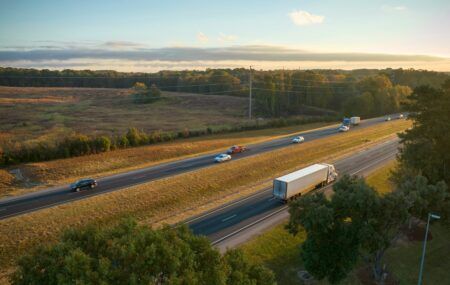In a project using computer vision, machine learning and sensors, scientists at the USA’s Oak Ridge National Laboratory (ORNL) are working with Gridsmart Technologies Inc. to demonstrate how stop lights can be programmed to improve fuel economy and reduce emissions while facilitating the smooth flow of traffic.
Developers of the iconic bell-shaped fish-eye lens camera and advanced traffic management system (ATMS), Gridsmart’s traffic cameras are already being used by communities around the world to replace in-road sensors traditionally used to detect vehicles and inform traffic signal timing. These smart cameras provide a real-time, bird’s eye view of intersections, gathering data that can guide timing and traffic flow strategies.
The goals of the ORNL program are to teach Gridsmart cameras to estimate the fuel efficiency of vehicles at intersections and then to control traffic signal timing to save energy while optimizing traffic throughput.
The fuel savings potential is substantial. The US Department of Energy (DOE) estimates that idling at intersections and other locations from heavy- and light-duty vehicles combined wastes about 6 billion gallons of fuel per year. The ORNL/Gridsmart project was one of the first awarded funding under the DOE Vehicle Technologies Office’s new High-Performance Computing (HPC) for Mobility (HPC4Mobility) program.
As part of the HPC for Energy Innovation Initiative, the program brings together the supercomputing resources and scientific expertise of DOE’s national laboratories in partnership with industry to find solutions to real-world transportation energy challenges. The project uses HPC systems at the ORNL Leadership Computing Facility, such as the Summit supercomputer; the world’s most powerful openly-accessible computer. The systems will be used to perform simulations of intersections and come up with mathematical strategies to guide traffic light timing.
The first phase for ORNL researchers has been to take images from Gridsmart’s overhead Bell Cameras and compare them to ground-level photos to create a database. The researchers want to train the cameras to estimate the fuel economy of various vehicles present at intersections by categorizing their size and vehicle class.
ORNL researchers developed a system to combine the resulting photos with fuel consumption data for different vehicle classes, which resulted in a rich dataset of labeled images. The second phase of the project is to create a software application by using reinforcement learning on ORNL’s supercomputers. Reinforcement learning basically teaches a computer how to play a ‘game’ without being explicitly programmed to do so; in this case, saving fuel while not sacrificing throughput.
“Creating an intelligent transportation system in traffic-dense urban areas requires observation beyond human capacity, and the amount of data generated by the Gridsmart cameras makes it an excellent fit for the HPC4Energy program,” noted project lead Tom Karnowski of ORNL’s Imaging, Signals and Machine Learning Group. “The whole idea is to teach cameras to estimate fuel consumption and then teach an entire grid of those cameras to manage traffic lights to make the system more fuel efficient.”
Jeff Price, Gridsmart’s chief technology officer, commented, “We are excited to be working with ORNL on this project. Multimodal urban mobility poses very complicated challenges. Bringing to bear ORNL capabilities in high-performance computing and machine learning on our unique data and large install base will provide some fascinating insights.”




